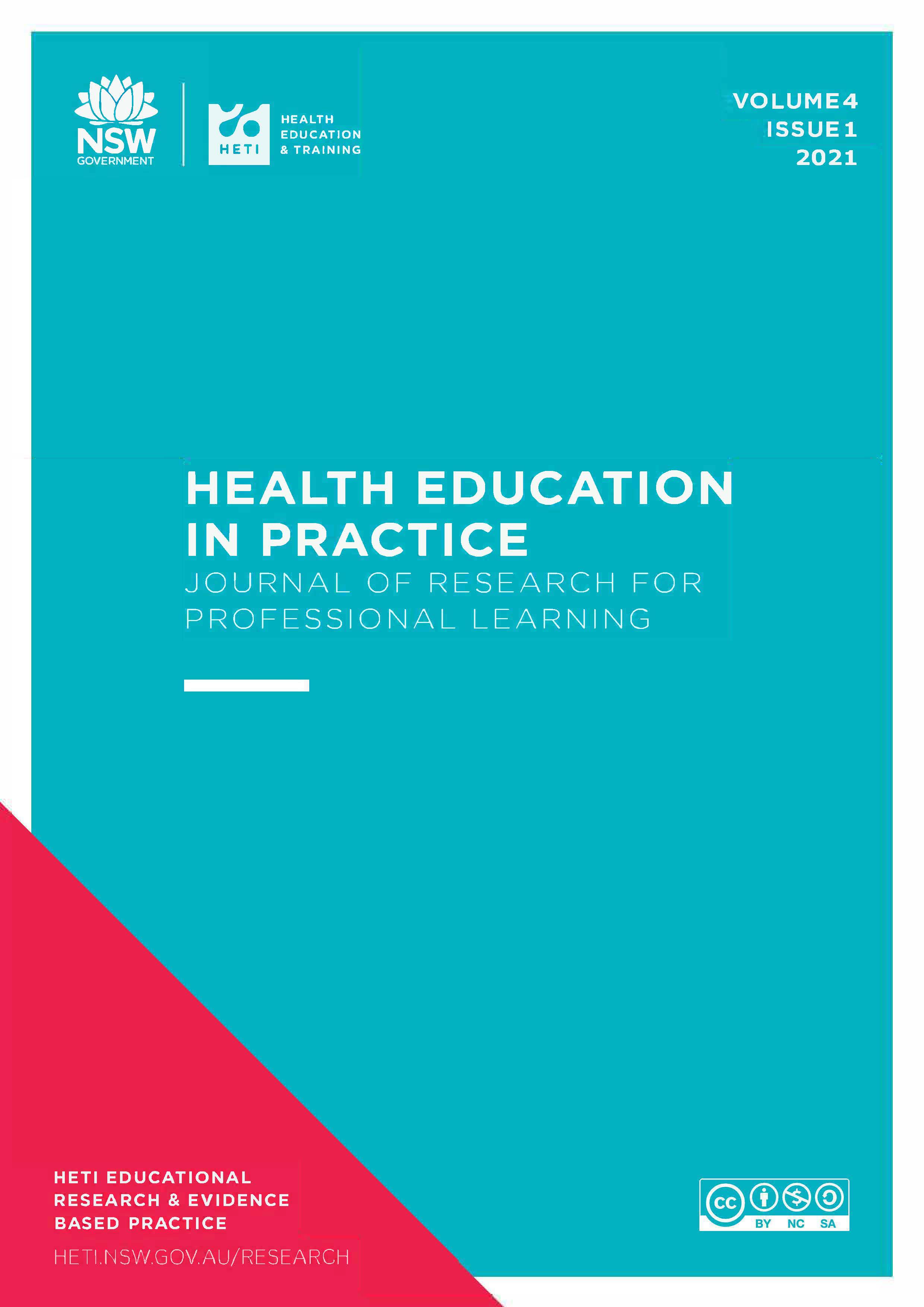The effect of rural placements on future rural general practice
DOI:
https://doi.org/10.33966/hepj.4.1.14798Abstract
Background: Providing health care to rural populations is a major issue in Australia. Disease burdenand health risk factorsincrease with remoteness, but the access to appropriate service decrease. The introduction of Rural Clinical Schools, rural locations for internship and residency, and decentralisation of the Australian General Practitioner Training Programaim to address this disparity. This systematic review aimed at determining if rural placements throughout medical training are associated with future rural general practice in Australia.
Methods: Medline (Ovid), Pubmed, CINAHL and Science Direct were searched for the period January 2000 to July 2019. Included studies related specifically to rural general practitioners in Australia and studies were excluded if they reported only on intention to practice rurally. Evidence was assessed using the Standards for Quality Improvement Reporting Excellence Guidelines.
Results: Eleven articles met the inclusion criteria. Three studies examined the effect of rural placements in medical school on future rural general practice. Three studies looked at placements as a junior doctor on future rural general practice. Four studies looked at the effect of rural general practitioner training on future rural general practice. One study reported on the effect of rural placements during both medical school and junior doctor years on future rural general practice. The studies supported an association between rural placements and future rural general practice, particularly for Australian born doctors, Australian graduates and individuals from rural backgrounds.
Discussion: This review suggests that rural placements during medical training increase the likelihood of future rural general practice. The interplay of personal and professional life influence whether rural intention is sufficient to result in rural practice. Addressing human factors that influence rural practice will contribute to achieving equitable rural health care.
Downloads
References
Australian Institute of Health and Welfare (AIHW) 2019, Rural & remote health, https://www.aihw.gov.au/reports/rural-remote-australians/rural-remote-health
Australian Institute of Health and Welfare 2017, Australia’s welfare 2017, AIHW, Canberra, https://www.aihw.gov.au/getmedia/088848dc-906d-4a8b-aa09-79df0f943984/aihw-aus-214-aw17.pdf.aspx?inline=true
Australian Institute of Health and Welfare 2018, Australia’s health 2018, AIHW, Canberra, https://www.aihw.gov.au/getmedia/7c42913d-295f-4bc9-9c24-4e44eff4a04a/aihw-aus-221.pdf.aspx?inline=true
Dunbabin, JS, McEwin, K & Cameron, I 2006, ‘Postgraduate medical placements in rural areas: Their impact on the rural medical workforce’, Rural and Remote Health, vol. 6, no. 2, p. 481. https://www.rrh.org.au/journal/article/481
Eley, DS, Synnott, R, Baker, PG & Chater, AB 2012, ‘A decade of Australian rural clinical school graduates—where are they and why?’, Rural and Remote Health, vol. 12, no. 1, p. 1937. https://www.rrh.org.au/journal/article/1937
Kitchener, S 2019, ‘Local regional workforce returns on investment of a locally governed and delivered general practice vocational training program’, Australian Health Review, vol. 44, no. 2, pp. 254–257. https://www-publish-csiro-au.ipacez.nd.edu.au/ah/AH18027
Kwan, MMS, Kondalsamy-Chennakesavan, S, Ranmuthugala, G, Toombs, MR & Nicholson, GC 2017, ‘The rural pipeline to longer-term rural practice: General practitioners and specialists’, PloS One, vol. 12 no. 7, pp. 1–15. https://doi.org/10.1371/journal.pone.0180394
Lewis, MJ, Ellis, R, Adusumilli, SK & Cameron, I 2016, ‘Twenty-five years on: Outcomes of a longitudinal evaluation of the NSW rural resident medical officer cadetship program’, Rural and Remote Health, vol. 16, no. 4, pp. 38–46. www.rrh.org.au/journal/article/3846
McGrail, MR, Russell, DJ & Campbell, DG 2016, ‘Vocational training of general practitioners in rural locations is critical for the Australian rural medical workforce.’ Medical Journal of Australia, vol. 205 no. 5, pp. 216–221. https://doi.org/10.5694/mja16.00063
Moher, D, Liberati, A, Tetzlaff, J & Altman, DG 2009, ‘Preferred reporting items for systematic reviews and meta-analyses: the PRISMA statement’, British Medical Journal, vol. 339, no. 7716, pp. 25–35. https://doi.org/10.1136/bmj.b2535
Murray, RB & Wronski, I 2006, ‘When the tide goes out: Health workforce in rural, remote and indigenous communities’, Medical Journal of Australia, vol. 185 no. 1, pp. 37–38. https://doi.org/10.5694/j.1326-5377.2006.tb00450.x
Department of Health 2016. National Strategic Framework for Rural and Remote Health, Canberra: Australia.https://www1.health.gov.au/internet/main/publishing.nsf/Content/A76BD33A5D7A6897CA257F9B00095DA3/$File/National%20Strategic%20Framework%20for%20Rural%20and%20Remote%20Health.pdf
O’Sullivan, BG, McGrail, MR, Russell, D, Chambers, H & Major, L 2018, ‘A review of characteristics and outcomes of Australia’s undergraduate medical education rural immersion programs’, Human Resources for Health, vol. 16, no. 1, pp. 8–10. https://doi.org/10.1186/s12960-018-0271-2
Ogrinc, G, Davies, L, Goodman, D, Batalden, PB, Davidoff, F & Stevens, D 2016, ‘SQUIRE 2.0 (Standards for Quality Improvement Reporting Excellence): Revised publication guidelines from a detailed consensus process’, BMJ Quality and Safety, vol. 25, no. 2, pp. 986–92. https://qualitysafety.bmj.com/content/25/12/986
Parlier, AB, Galvin, SL, Thach, S, Kruidenier, D & Fagan, EB 2018, ‘The road to rural primary care: A narrative review of factors that help develop, recruit, and retain rural primary care physicians’, Academic Medicine, vol. 93, no. 1, pp. 130–140. https://doi.org/10.1097/ACM.0000000000001839
Peach, HG, Trembath, M & Fensling, B 2004, ‘A case for more year‐long internships outside metropolitan areas?’, Medical Journal of Australia, vol. 180, no. 3, pp. 106–108. https://doi.org/10.5694/j.1326-5377.2004.tb05829.x
Playford, DE, Ng, WQ & Burkitt, T 2016, ‘Creation of a mobile rural workforce following undergraduate longitudinal rural immersion’, Medical Teacher, vol. 38, no. 5, pp. 498–503. https://doi.org/10.3109/0142159X.2015.1060304
Robinson, M & Slaney, GM 2013, ‘Choice or chance! the influence of decentralised training on GP retention in the Bogong region of Victoria and new south wales’, Rural and Remote Health, vol. 13, no. 1, pp. 22–31. www.rrh.org.au/journal/article/2231
Wearne, S, Giddings, P, McLaren, J & Gargan, C 2010, ‘Where are they now?: The career paths of the remote vocational training scheme registrars’, Australian Family Physician, vol. 39, no. 1, pp. 53–56. https://search-informit-com-au.ipacez.nd.edu.au/documentSummary;dn=711674372039846;res=IELHEA
Wilkinson, D, Laven, G, Pratt, N & Beilby, J 2003, ‘Impact of undergraduate and postgraduate rural training, and medical school entry criteria on rural practice among Australian general practitioners: National study of 2414 doctors’, Medical Education, vol. 37, no. 9, pp. 809–814. https://doi.org/10.1046/j.1365-2923.2003.01596.x

